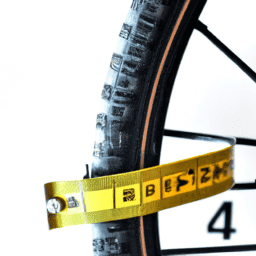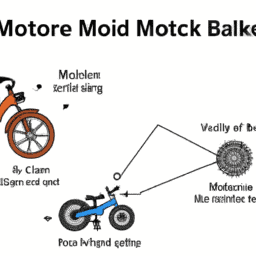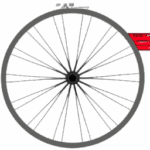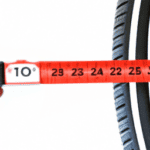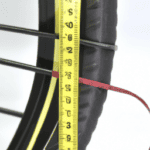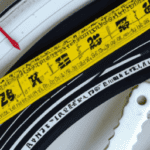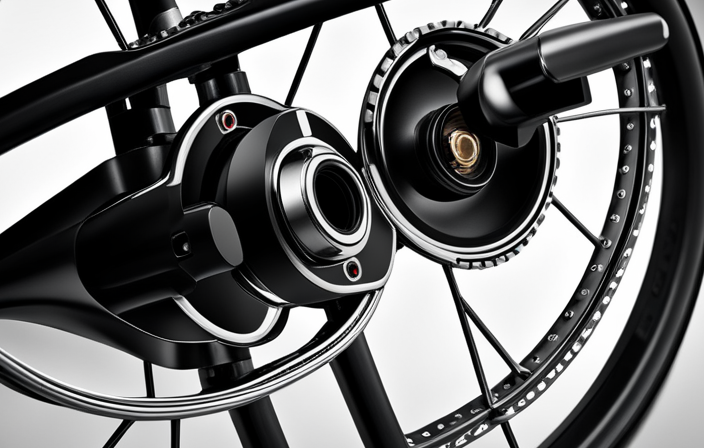For cycling enthusiasts, understanding the significance of proper gear cannot be overstated, and among the key features of a bicycle, the rims hold a paramount place. Determining the dimensions of your bike’s rims is vital not only for choosing suitable tires and add-ons but also for guaranteeing top-notch performance and safety.
In this article, we’ll walk you through the process of measuring your bicycle rim size, step by step.
To start, you’ll need a few tools, including a tape measure, a ruler, and a caliper. Determining the type of rim you have is also important, as different types of rims require different measurements.
Once you have the necessary tools and have identified your rim type, you can measure the diameter and width of your rim. With these measurements, you’ll be able to select the right tires and accessories for your bike, as well as make any necessary adjustments to ensure optimal performance.
So, let’s get started!
Key Takeaways
- Measuring rim size is crucial for selecting the right tires and accessories, ensuring optimal performance and safety.
- Different rim types require different measurement techniques, including measuring diameter, width, and bead seat diameter.
- Checking rim compatibility is important before purchasing new parts.
- Selecting the right tires and accessories for the rim size and type of riding can enhance the cycling experience and prevent handling issues and punctures.
Gather the Necessary Tools
Now, let’s gather the tools you’ll need to measure your bike rim size – don’t worry, it’s a breeze! Proper tool selection is crucial in obtaining accurate measurements, so make sure you have a reliable measuring tape or ruler.
A caliper can also be used for more precise measurements. Accurate measurements are important because they affect the fit and performance of your bike’s tires, as well as the compatibility of replacement parts.
Once you have your measuring tools ready, you can move on to determining the type of rim you have.
Determine the Type of Rim
Imagine you’re shopping for shoes and need to determine the type of sole before making your purchase. In the same way, before you can measure your bicycle rim size, you must first identify the type of rim you have.
There are various types of rims available in the market, and each one has its own specific features and measurements that you need to consider. To identify rim types, you can start by checking the manufacturer’s specifications or markings on the rim.
Most rims will have the size and type of the rim etched on the side of the rim. You can also look for other markings like the model number or the brand name. Checking rim compatibility is also important before purchasing any new parts.
Some rims are only compatible with specific types of tires, tubes, or hub configurations, so it’s important to make sure that the new part you’re purchasing is compatible with your rim. Now that you’ve identified the type of rim you have, you can move on to measuring the rim diameter.
Measure the Rim Diameter
To measure the diameter of your bicycle rim accurately, you need to know whether it’s a clincher, tubular, or tubeless rim.
For clincher rims, you can measure the bead seat diameter using a caliper. For tubular rims, you need to measure the outer diameter of the rim. For tubeless rims, the diameter is usually marked on the rim itself, but you can also measure it using a caliper.
Knowing how to measure the diameter of your rim will help you choose the right size of tire and ensure optimal performance while riding.
How to Measure Clincher Rims
First, you’ll need to locate the bead seat diameter on the rim to accurately measure your clincher rim size. This is the inner diameter of the rim where the tire bead sits. Common mistakes include measuring the outer diameter of the rim or measuring the distance between the tire sidewalls. To avoid these errors, use a caliper or ruler to measure the bead seat diameter directly.
Tips for accuracy and precision include measuring in millimeters for greater accuracy and taking multiple measurements to ensure consistency. If you receive a measurement that doesn’t match the labeled size of the rim, try troubleshooting by checking for any hidden damage or deformities in the rim.
With a proper measurement of the bead seat diameter, you can now move on to measuring your tubular rim size.
How to Measure Tubular Rims
Now that you’ve located the proper diameter for your clincher rim, it’s time to move onto the next step in accurately determining the size of your tubular wheel. Measuring tubular rims requires a different approach than measuring clincher rims, and there are some tips and tricks to keep in mind to avoid common mistakes.
Here are some things to keep in mind when measuring tubular rims:
- Use a caliper or ruler to measure the width of the rim, from edge to edge.
- Measure the distance between the center of the rim and the rim bed to determine the depth.
- Take note of the valve hole placement, as this can affect the overall dimensions.
- Be sure to measure both the front and rear rims, as they can sometimes have different dimensions.
- Double-check your measurements to ensure accuracy.
Moving on to measuring tubeless rims, the process is similar to measuring clincher rims, but there are a few key differences.
How to Measure Tubeless Rims
Measuring the width and depth of your tubeless wheel can be tricky, but you can easily determine its dimensions with the right tools and techniques. First, you need to remove the tubeless tire from the rim. Tubeless tire installation is different from traditional tire installation, as it requires a special sealant to prevent air from leaking out.
Once the tire is removed, place the rim on a flat surface. Use a caliper to measure the outer width of the rim from one side to the other. This will give you the overall width of the rim.
Next, use a depth gauge to measure the distance from the outer edge of the rim to the inner edge where the tire sits. This will give you the depth of the rim.
Knowing the width and depth of your tubeless rim is important for several reasons. First, it allows you to choose the right size tire for your wheel. Second, it helps you determine the benefits of tubeless tires, which include reduced rolling resistance, improved traction, and fewer flats.
With these measurements in hand, you can move on to measuring the rim width.
Measure the Rim Width
To accurately determine the size of your bicycle rim, it’s essential to take into account the width of the rim. Rim thickness measurement is not the same as rim width measurement. Rim width is the distance between the inner edges of the rim walls and is typically measured in millimeters.
Here are three easy steps to measure your rim width accurately:
-
Take off your tire: Before measuring the width, remove the tire from the rim. This step ensures that you get an accurate measurement of your rim’s width without any interference from the tire.
-
Use a ruler or caliper: To measure the rim’s width, place a ruler or caliper on the flat surface of the rim. Hold it perpendicular to the rim’s diameter and measure the distance between the inner edges of the rim walls.
-
Record the measurement: Write down the measurement in millimeters. Make sure to measure both the front and rear rims of the bike to ensure consistency.
With the accurate measurement of your bicycle rim’s width, you can now use the measurements to select the right tires and accessories.
Use the Measurements to Select the Right Tires and Accessories
Once you’ve accurately determined the width of your rim, you can easily choose the perfect tires and accessories to enhance your cycling experience.
Choosing tires that fit your rim size is crucial for both performance and safety. Tires that are too narrow or too wide for your rim can cause handling issues and increase the risk of punctures or blowouts. On the other hand, tires that are compatible with your rim size will provide a smooth and comfortable ride, as well as better traction and control.
To find compatible accessories, you’ll need to consider the specifications of your rim and the type of riding you’ll be doing. For example, if you have a wider rim, you may need to use wider brake pads or a longer valve stem on your inner tubes.
If you’re planning to ride in wet or muddy conditions, you may want to invest in fenders to protect yourself and your bike from dirt and water splashes.
By taking the time to research and select the right tires and accessories for your rim size, you’ll be able to enjoy a more comfortable and efficient ride.
Frequently Asked Questions
Can I use any tire with my bicycle rim or do I need to consider compatibility?
Before buying a tire, consider tire compatibility with your bike’s rim. Common rim and tire pairings vary depending on the type of bike. Ensure the tire width and diameter are compatible with your rim to avoid issues.
Is it possible to measure the rim size without removing the tire?
You may have heard that it’s impossible to measure rim size without removing the tire, but that’s not entirely true. Measuring accuracy can vary, but there are different methods that can give you a rough estimate.
How do I know if my rim is tubeless compatible?
To determine if your rim is tubeless compatible, look for markings on the rim or check the manufacturer’s website. Tubeless advantages include reduced punctures and lower tire pressure. Converting non tubeless rims requires a conversion kit and may require professional installation.
What is the difference between a clincher and a tubular rim?
Did you know that the majority of road cyclists use clincher rims? Unlike tubular rims, clinchers are easier to maintain and offer better convenience with their ability to easily swap tires. To keep your rims clean, use a mild soap and water, and avoid harsh chemicals.
How often should I check the size of my bicycle rim?
It’s important to regularly check your bicycle rim size to avoid consequences such as decreased performance and safety issues. Neglecting to do so can result in improper tire fit and potential accidents.
Conclusion
Congratulations! You’ve successfully measured your bicycle rim size. With the right tools and a bit of knowledge, you can now confidently select the right tires and accessories for your bicycle.
Remember, the type of rim will determine the measurements needed to select the right components. Whether you’re measuring the diameter or the width of the rim, accuracy is key. So, take your time and double-check your measurements to ensure you get the right fit for your bike.
As you continue to explore the world of cycling, keep in mind the importance of proper maintenance and the role it plays in ensuring your bike is safe and efficient. By taking the time to measure your bicycle rim size and selecting the right tires and accessories, you’re taking a step towards a smoother and more enjoyable ride.
So, get out there and ride with confidence, knowing that you have the knowledge and skills to keep your bike rolling smoothly. And let’s face it, whether you’re a pro cyclist or just a casual rider, it’s always important to know your rim size. After all, you wouldn’t want to be caught with the wrong size, like wearing shoes that are too small or too big.
